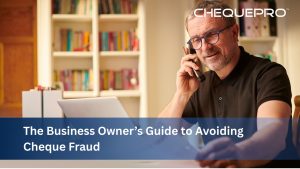Introduction
People think of a cheque as just a slip of paper to pay someone. But it can turn into a big problem if you aren’t careful. A single cheque can move a huge sum of money, and if it lands in the wrong hands? You could lose everything in seconds.
That’s why cheques are a favourite target for scammers. This isn’t just some rare problem either. In India alone, banks lost around ₹36,000 crore to fraud in 2024-25. In the U.S., almost 63% of organisations said they faced cheque fraud last year.
It’s a serious issue everywhere. You can only stop them if you know how these scams work. Let’s look at some of the danger signs and effective safeguards against cheque fraud in this blog.
The Numbers Are Alarming
Let’s have a look:
| Country | 2021 Cases | 2022 Cases | YoY Growth |
| US | 350,000 | 680,000+ | 94% |
| India | ₹13,000+ Cr | ₹36,000+ Cr | ~3X |
Real-World Cases of Cheque Fraud
Let’s have a look at some of the real-world cases of cheque fraud:
- Bhopal, 2023: Some thieves stole a man’s cheque book and forged his signature and used that to transfer about ₹41.36 lakh from his account. All this time, the man had no idea about all this and came to know about the loss of money after three months.
- San Antonio: There was another case I read about where a big fraud ring in the U.S. ran a large counterfeit cheque operation. For this, they used fake identities and remote deposit capture. The police later found out that they had stolen a total of $2.5 million.
- Axis Bank Case: This case will tell you how even banks are not spared from cheque fraud. In Axis Bank, many people’s accounts were emptied because fake cheques were deposited in their names. This case lasted for a lengthy span of 15 years. After such a long time, at last, the victims were given compensation worth ₹73.9 lakh for this fraud.
Also Read: Top Benefits of Bulk Printing for Efficient Document Management
Red Flags You Shouldn’t Ignore
Each forged cheque contains some sort of tip that it may be forged. You simply need to know how to identify these warning signs. Let’s look at some of the common ones:
Physical Signs
- Paper that feels too light or flimsy: A real cheque always has a certain weight to it. But if it feels cheap and like printer paper, then it can be fake.
- Weird stains or patches: If your cheque has weird stains or patches, it could mean that the cheque’s been chemically “washed” so someone could rewrite the details.
Formatting Issues
- Numbers that look odd or tampered with: Check the MICR line at the bottom. If it looks smudged or slightly misaligned, then I would suggest that you verify with the bank first.
- Cheque numbers out of order: If your cheque numbers usually go one after the other, like 2051, 2052, and suddenly one shows up as 3127, that’s a red flag. It could be fake.
- Faded ink: If the ink looks faded or the printing looks off, there’s a good chance the cheque isn’t original.
Behavioural Issues
- Watch people’s behaviour: If someone keeps pushing you to clear the cheque right away, slow down. Double-check with your bank before trusting them.
- Amounts way higher than usual: When a vendor who usually sends a cheque of an amount way higher than usual, then this might be a scheme of a fraudster trying to scam you.
- Refund requests for “accidental overpayment”: After the scammers overpay on purpose, they next ask you to give them the extra money they accidentally sent back. This is one of their most common trick.
Safeguards That Actually Work
I would suggest the following defences to protect your business from cheque fraud:
| Safeguard | Why It Works |
| Tamper-Proof Printing | Auto-converts numbers to words and locks payee data; ensures no edits are possible after printing |
| Maker-Checker Workflow | Adds dual approval and stops insider fraud before payment is released |
| Positive Pay | Bank cross-checks cheques with your issued list and flags mismatches |
| ERP Integration | Blocks duplicates and syncs cheque data instantly |
Process Tweaks That Make a Big Difference:
Now, we’ll look at changes you can make in your payment process to stay safe:
- Split responsibilities:
When just one person is in charge of cheque payments, cheque fraud is easier. That one person can approve, sign, and process cheques without anyone there to check their work. To avoid this, I suggest dividing the responsibility between at least two people.
So, one person can prepare the cheque and the other person can approve or sign it. This way, there is a system which makes it difficult for anyone to commit fraud without being noticed.
- Secure your cheque books:
Cheque books can be misused very easily. So, you should always keep them safe and allow only trusted people to access them.
Many big companies leave blank signed cheques lying around. Fraudsters can easily misuse those cheques by filling in their own names or amounts. So it’s very important to keep your cheque books safe.
- Train your team regularly:
You need to keep training your people and teams because the scammers are not going to come at you the same way they might have tried earlier.
They keep changing their techniques to scam people. In such a case, it becomes important to keep your team updated and aware of the latest fraud techniques. This will help them detect any fraud early and stop it.
Also Read: Prevent Fraud with Advanced Cheque Security Solutions
Conclusion
In the end, I’ll say that staying safe and avoiding risk is not very difficult. Use the tools I’ve mentioned above to protect yourself from cheque fraud and stay alert about every cheque you come across.
Criminals now are combining old tricks like cheque washing with modern tools like AI and synthetic identities. You should also make sure your defences are advanced and foolproof.
To sum it up, I would just say to check every cheque and trust your gut. That’ll help you stay safe and away from fraudsters.





